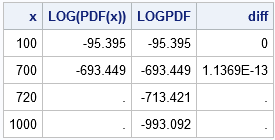At a conference last week, a presenter showed SAS statements that compute the logarithm of a probability density function (PDF). The log-PDF is a a common computation because it occurs when maximizing the log-likelihood function.
The presenter computed the expression in SAS by using an expression that looked like
y = LOG(PDF("distribution", x, params));
In other words, he computed the PDF and then transformed the density by applying the LOG function.
There is a better way. It is more efficient and more accurate to use the LOGPDF function to compute the log-PDF directly.
Special functions for log-transformed distributions #SASTip Click To TweetLog-transformed distributions
SAS provides several functions for computing with log-transformed distributions. In addition to the LOGPDF function, you can use the LOGCDF function to compute probabilities for the log-distribution.
Let's use the gamma distribution to see why the LOGPDF function is usually more efficient.
The gamma density function with unit scale parameter is given by
f(x; a) = xa-1 exp(-x) / Γ(a)
where Γ(a) is the value of the gamma function evaluated at a.
The log-transform of the gamma density is
log(f(x; a)) = (a-1)log(x) – x – log(Γ(a))
This formula, which is used when you compute LOGPDF("gamma", x, 2), is cheap to evaluate and does not suffer from numerical underflow when x is large. In particular, recall that
in double-precision arithmetic, exp(-x) underflows if x > 709.78, so the PDF function cannot support extremely large values of x. In contrast, the formula for the log-PDF does not experience any numerical problems when x is large. The log-PDF function is also very fast to compute.
The following DATA step illustrates how to use the LOGPDF function to compute the log-gamma density. It computes the log-gamma PDF two ways: by using the LOGPDF function and by using the log-transform of the gamma PDF. The results show that the numerical values are nearly the same, but that the PDF function fails for large values of x:
data LogPDF(drop=a); a = 2; do x = 100, 700, 720, 1000; LogOfPDF = log( pdf("Gamma", x, a) ); LOGPDF = logpdf("Gamma", x, a); /* faster and more accurate */ diff = LOGPDF - LogOfPDF; output; end; label LOGOfPDF = "LOG(PDF(x))"; run; proc print noobs label; run; |

By the way, SAS provides other functions that are optimized for computing the log-transformation of several well known funcions and quantities:
- The LOGBETA function computes the logarithm of the beta function. You should use logbeta(a,b) instead of log(beta(a,b)).
- The LGAMMA function computes the logarithm of the gamma function. You should use lgamma(a) instead of log(gamma(a)).
- The LCOMB function computes the logarithm of the number of combinations of n objects taken k at a time. You should use lcomb(n,k) instead of log(comb(n,k)).
- The LFACT function computes the quantity log(n!) for specified values of n. You should use lfact(n) instead of log(fact(n)).
In general, when software provides a function for directly computing the logarithm of a quantity, you should use it. The special-purpose function is typically faster, more accurate, and will handle arguments that are beyond the domain of the non-specialized function.

2 Comments
Pingback: Two simple ways to construct a log-likelihood function in SAS - The DO Loop
Pingback: Pi and products - The DO Loop